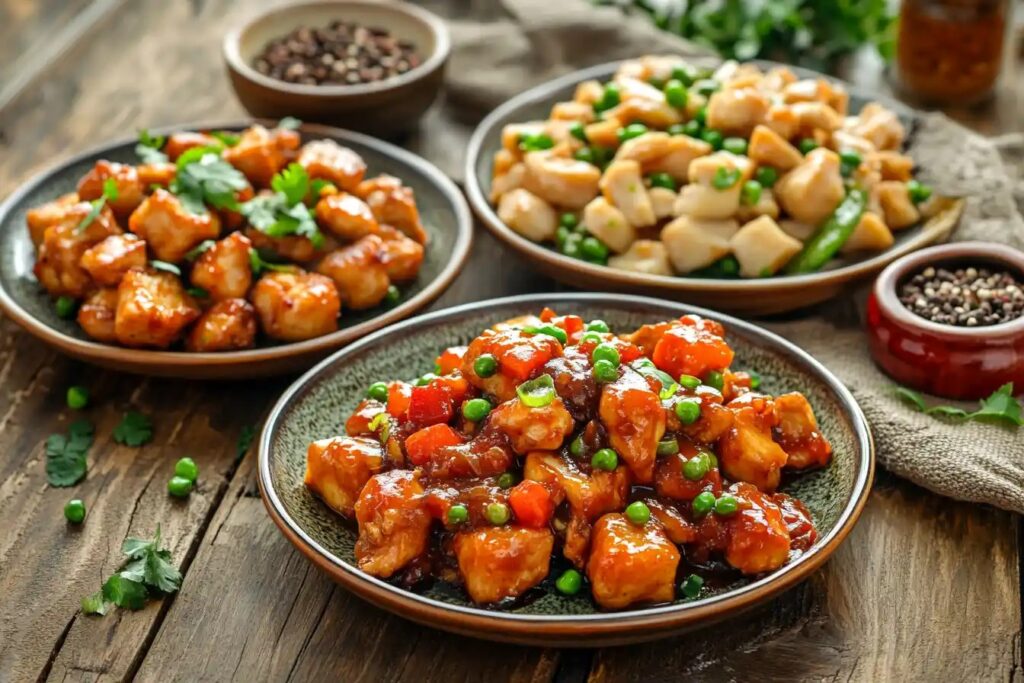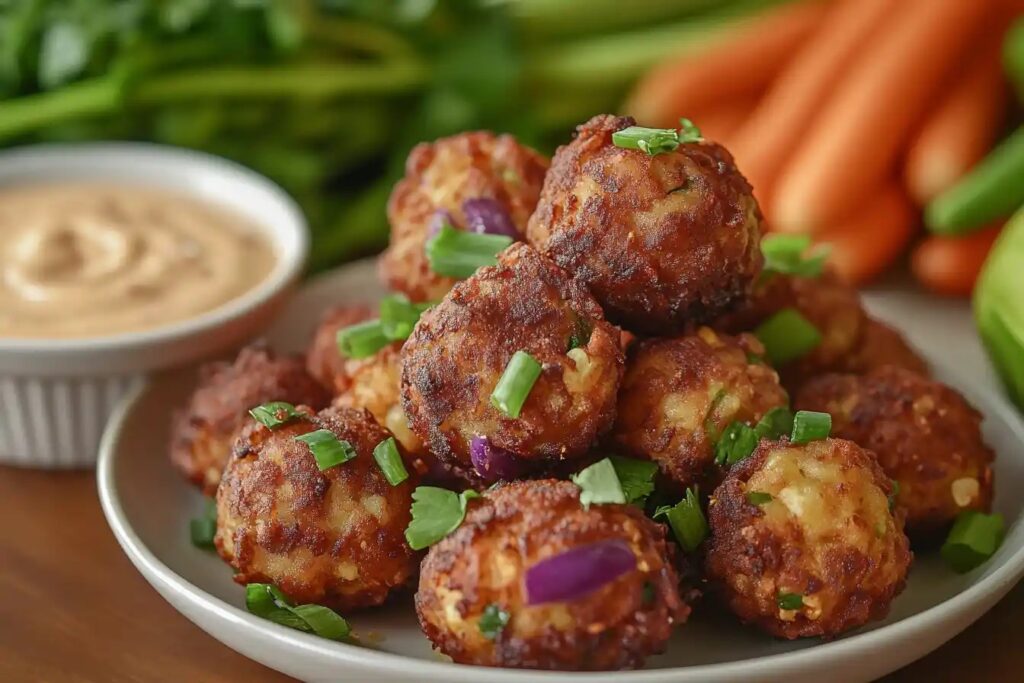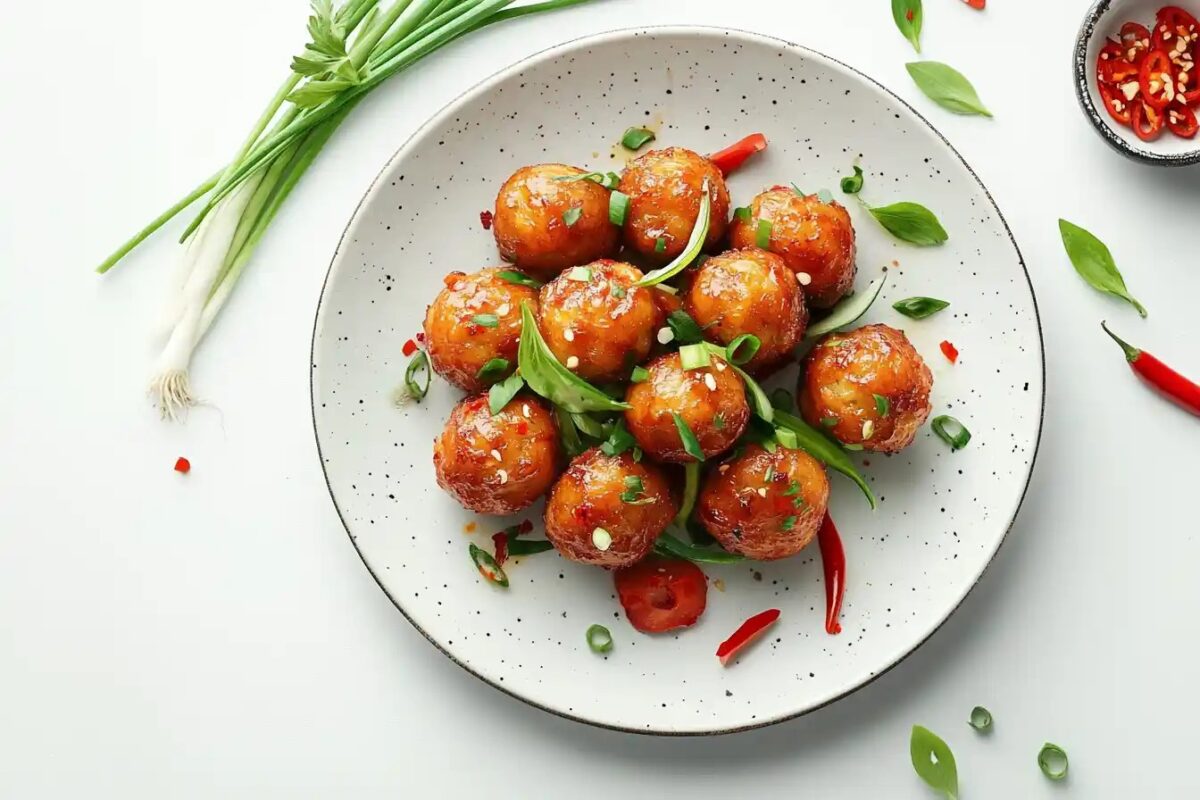Introduction
Manchurian, a beloved Indo-Chinese dish, has carved out a special place on menus worldwide. Known for its bold flavors and versatility, this dish is a fusion masterpiece made from vegetables, meat, or gobi (cauliflower), paired with tangy, spicy sauces. But how does it stack up in terms of health? This article dives deep into Manchurian’s nutritional profile, exploring its benefits, drawbacks, and how to make it a healthier choice. We’ll also tackle burning questions like, “Is Manchurian healthy to eat?” and “Does Manchurian contribute to cholesterol levels?”
Without further ado, let’s kick off with a closer look at this dish and what makes it so irresistible.
Introduction to Manchurian
What is Manchurian?
Manchurian is a fusion dish that combines the robust, spicy elements of Chinese cuisine with Indian tastes. Typically served as a starter or a main course, it’s prepared by frying small balls made from vegetables, chicken, or gobi and coating them in a rich, flavorful sauce. The sauce often includes ingredients like soy sauce, garlic, ginger, and green chilies, creating a zesty kick.
The Origins of Manchurian: Indo-Chinese Cuisine
Manchurian’s roots trace back to India, where chefs blended Chinese cooking techniques with local ingredients to appeal to Indian palates. This culinary marriage led to what is now known as Indo-Chinese cuisine. While it borrows heavily from traditional Chinese dishes, Manchurian is uniquely Indian in its seasoning and preparation, making it a staple on Indian restaurant menus and street food stalls.
Why Manchurian is Popular Across Age Groups
Manchurian’s popularity knows no bounds. Its crispy texture and umami-packed flavor appeal to everyone, from kids craving indulgence to adults looking for comfort food. The dish’s ability to adapt—whether as a vegetarian delight or a meaty treat—further adds to its universal charm.
Nutritional Facts of Manchurian

Calories in Different Types of Manchurian
The calorie count in Manchurian varies significantly based on its type and preparation. Vegetable Manchurian, often considered a lighter option, contains about 150-200 calories per serving. In contrast, Chicken Manchurian or Gobi Manchurian can climb up to 300 calories due to frying and rich sauces. These numbers increase with deep frying, making it essential to consider portion sizes.
If you’re keen to explore homemade versions, check out this Chicken Manchurian Recipe for a healthier twist.
Breakdown of Macronutrients: Carbs, Proteins, and Fats
Manchurian is rich in carbohydrates, primarily derived from flour or cornflour used in batter preparation. Protein content is higher in chicken-based varieties, while fat levels depend on the frying method. However, vegetable versions offer more dietary fiber, making them a slightly better choice for digestive health.
Comparison with Similar Dishes
When compared to other Indo-Chinese dishes, such as fried rice or noodles, Manchurian tends to have a higher calorie density due to its fried nature. Opting for stir-fried or steamed variations can help reduce the calorie load. This balance ensures you enjoy the dish without overindulging.
Health Benefits of Eating Manchurian
Nutritional Positives of Vegetable-Based Manchurian
Vegetable Manchurian stands out as the healthiest among its peers, thanks to its inclusion of finely chopped vegetables like cabbage, carrots, and bell peppers. These veggies are loaded with vitamins A and C, contributing to better immunity and eye health. Plus, they bring a good dose of antioxidants, which fight off harmful free radicals.
Role of Vegetables in Boosting Fiber and Vitamins
The high fiber content in vegetable-based Manchurian aids digestion and promotes a feeling of fullness, making it a sensible choice for those watching their weight. Meanwhile, the vitamins help maintain energy levels, ensuring you can enjoy this dish guilt-free on occasion.
How Homemade Manchurian Can Be Healthier
When preparing Manchurian at home, small changes can make a big impact on health. Swapping refined flour with whole-wheat flour or cornstarch and reducing oil usage are great places to start. Incorporating homemade sauces with less sodium and sugar can transform this treat into a balanced meal.
Potential Downsides of Manchurian
High-Calorie Content and Its Implications
One of the main concerns about Manchurian is its calorie density, particularly when deep-fried. A single serving can pack 300+ calories, depending on the ingredients and cooking method. This calorie count makes it less ideal for regular consumption, especially for those aiming to maintain or lose weight. The use of refined flour and deep-frying adds unhealthy fats, which can contribute to weight gain and cardiovascular issues over time.
Is Manchurian Considered Processed Food?
Manchurian often relies on sauces high in sodium, preservatives, and artificial flavors, especially when using store-bought options. This makes the dish borderline processed. These additives can lead to bloating, increased blood pressure, and water retention, particularly when consumed in large amounts. Opting for homemade sauces with fresh ingredients significantly reduces these risks.
Impact of Excess Sodium and Sauces on Health
The tangy sauces that make Manchurian so addictive can also be a health trap. These sauces often contain excessive sodium and sugar levels, which can spike blood pressure and blood sugar. This is particularly concerning for individuals with pre-existing conditions such as hypertension or diabetes.
Does Manchurian Contribute to Cholesterol Levels?
Deep-fried Manchurian can be high in trans fats, which are known to increase bad cholesterol (LDL) and lower good cholesterol (HDL). Over time, this imbalance can raise the risk of heart diseases. Switching to air-fried or baked Manchurian is a heart-friendly alternative worth considering.
Making Manchurian Healthier

Choosing Ingredients Wisely: Low-Calorie Alternatives
A healthier Manchurian begins with smarter ingredient choices. Instead of refined flour, try using whole-grain or almond flour for the batter. Similarly, you can swap frying for air-frying or baking to drastically cut down on unhealthy fats without compromising on taste.
Switching to Homemade Sauces
Homemade sauces allow you to control what goes into your dish. Preparing sauces with fresh tomatoes, garlic, ginger, and low-sodium soy sauce ensures you enjoy the flavors without loading up on preservatives or extra sodium. This small change can significantly improve the dish’s nutritional value.
Exploring Baked or Air-Fried Options
The cooking method plays a huge role in determining how healthy is Manchurian. Air-fried Manchurian retains its crispy texture without soaking up unhealthy fats, while baking offers a delicious and guilt-free option. Both methods significantly reduce calorie content, making them perfect for health-conscious food lovers.
For more exciting and healthier recipe ideas, explore articles like Why Is My Manchurian Not Crispy? to level up your cooking game.
Manchurian and Weight Management
How to Incorporate Manchurian into a Balanced Diet
Balancing indulgence with health is key to enjoying Manchurian without guilt. While its flavors are undeniably tempting, moderation is crucial. Pairing Manchurian with a side of steamed vegetables or a fresh salad can offset the calorie load while adding essential nutrients. Opting for smaller portions and savoring every bite can also help maintain control over calorie intake. So, how healthy is Manchurian? It depends largely on how you prepare and pair it with other foods in your meal plan.
Burning Calories: Exercises Post Consumption
After indulging in Manchurian, staying active can help offset its calorie content. A brisk 30-minute walk or light cardio session can burn 150–300 calories, effectively balancing out a single serving. Activities like yoga or stretching can also help improve digestion, ensuring your body processes the meal efficiently. Remember, staying consistent with exercise supports overall health and allows occasional treats like Manchurian to fit into your lifestyle seamlessly.
FAQs About Manchurian
Is Manchurian Healthy to Eat?
Manchurian can be healthy if prepared with fresh, wholesome ingredients and cooked using low-fat methods like baking or air-frying. Homemade versions often trump restaurant options, which tend to be calorie-heavy and loaded with sodium.
Is Manchurian High in Calories?
Yes, traditional Manchurian recipes can be high in calories, especially if deep-fried and served with rich sauces. However, baked or air-fried alternatives can significantly reduce the calorie count.
Is Manchurian Processed Food?
Manchurian is not inherently processed, but store-bought sauces and ready-made mixes can make it fall into that category. Opting for fresh, homemade ingredients is a healthier choice.
Does Manchurian Increase Cholesterol?
Fried Manchurian can contribute to cholesterol issues due to trans fats. Choosing air-fried or baked methods and using heart-healthy oils can help mitigate this risk.
Conclusion: Balancing Taste and Health
Summary of the Health Aspects of Manchurian
Manchurian’s reputation as a flavorful dish comes with its pros and cons. When prepared traditionally, it can be high in calories, sodium, and unhealthy fats, posing risks for weight management and heart health. However, it’s not all bad news. By making small yet significant changes—like using fresh, nutrient-rich ingredients and choosing healthier cooking methods—you can enjoy Manchurian in a more balanced way. So, how healthy is Manchurian? The answer lies in how it’s made and consumed.
Final Thoughts on Moderation and Lifestyle
Like most indulgent dishes, Manchurian is best enjoyed in moderation. It’s a great option for special occasions or when you crave bold, vibrant flavors. Pairing it with lighter sides or incorporating it into a nutrient-rich meal plan ensures you get the best of both taste and health. Remember, it’s all about balance—small, mindful choices can make your favorite dishes a part of your healthy lifestyle.
Practical Tips for Enjoying Manchurian Healthily
Make It a Family Affair
Cooking Manchurian at home not only allows you to control the ingredients but also brings the family together. Experiment with healthier versions, like baked or air-fried Manchurian, and let everyone customize their flavors.
Plan Around Your Cravings
If you’re craving Manchurian, plan your meals for the day to accommodate its calorie content. Opt for lighter, nutrient-dense foods earlier in the day, ensuring you still meet your dietary goals while satisfying your taste buds.
For more exciting recipes and tips, explore Why Is My Manchurian Not Crispy? for insights into perfecting your cooking techniques.
